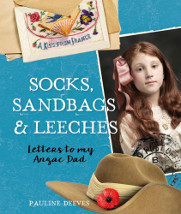Socks, sandbags & leeches: letters to my Anzac dad by Pauline Deeves

National Library of Australia, 2016. ISBN 9780642278845
(Age: 10+) Recommended. World War One, Anzac, Home front,
Propaganda. Through Ivy's letters to her father at Gallipoli during
the eight months that the Anzac troops were stationed there, and
after in France, we see what life is like at the Home Front, as she
and her mother have to move in with Aunt Hilda, the small flat
barely accommodating them. The twenty letters sent between 1914 and
1918, describe the attitudes at home, the volunteer work done, the
lack of money, the making do, the work of the cheer up society, the
growing prejudice against those with German ancestry, and the
propaganda disseminated to the populace.
Each letter is illustrated with pictures from the times, sourced
from the archives at the National Library of Australia, and
indicative of society and its attitudes during World War One. For
students to find out how children coped with their fathers away at
war, and their family so confined by restrictions of war time, then
this book will be a fascinating resource for the classroom and
library. For older readers, it is an interesting factual book, as
each letter reveals something about Australia at war, and for many
the book will be like a memoir, a story to be read from start to
finish, gaining a great deal of information about life in Australia
one hundred years ago.
One letter amongst many which took my interest is about Fundraising.
In the letter, Ivy tells of their visit to the local doctor's house,
opened to raise finds for the Red Cross. She describes things about
the house which would interest her father. Around the letter are
many examples of fund raising activities with posters of the Red
Cross Nurse, and a Gala Day. One poster shows an extravagant woman
spending money on frivolous things, exhorting women to be thrifty,
while another details the work done by the Education Department's
War Relief Fund in Victoria. Each poster gives more information
about the work done in raising money and awareness.
A detailed index appears after a glossary and fascinating list of
illustrations, giving details of where all the illustrations came
from, all designed to add weight to an already impressive resource
book.
This is a book to use in the classrooms or just to dip into for an
insight into how children coped with being on the home front during
war time.
And a fascinating fact I came across: St Kilda Football Club changed
their colours because they wee also Germany's colours, is one
example of the range of information given sure to have broad appeal.
Fran Knight